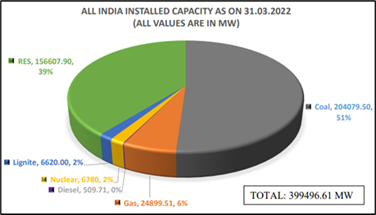

3rd April 2023 (7 Topics)
Context
The National Electricity Plan (NEP) 2022-27 has been rolled out which marks a discernible reversal in the policy thrust from its last edition.
Need of the initiative:
- India is now amongst the fastest developing countries in the world in terms of GDP as well as electricity consumption.
- The challenge is to meet the energy needs of high economic growth & electricity consumption of about 1.3 billion people.
- The development of an efficient, coordinated, economical and robust electricity system is essential for the smooth flow of electricity from generating stations to load centres (as per the Electricity Act, 2003).
- Also, optimum utilization of resources in the country, to provide reliable, affordable, uninterruptible (24x7) and Quality Power for All.
Highlights of the draft:
- The coal energy thrust: The fresh draft, in a tacit admission of the ground realities, cites the need for fresh coal-based capacity ranging from 17 GW to nearly 28 GW till 2031-32.
- This would be over and above an under-construction coal-based capacity of 25GW (1 gigawatt or GW is equal to 1000 megawatts or MW).
- An increase in the plant load factor (PLF) of coal-fired plants from 55% up to 2026-27 to 62% in 2031-32.
- The renewable energy thrust: A projected battery storage requirement in 2031-32 of between 51 GW to 84GW with a daily usage rate of 5 hours.
- Estimated to be Rs.10 crore per MW, this could translate into investments into battery storage between Rs.5 - 8 lakh crore over the next ten years as a backup for renewable capacity.
- Battery Energy Storage System: Battery Energy Storage systems (BESS) especially based on Lithium-ion batteries are one of the storage options.
- Hybrid generation models: This will perform solar energy shifts and provide backup power.
- Hydro-based plants:
- It also said that in the event of delay in the achievement of hydro-based plants, which are in concurred/under construction stage, there is an additional requirement of coal of around 4 GW in the capacity mix in 2026-27.

What are the Challenges Ahead?
- The continued reliance on old, inflexible coal-fired plants for base load capacity.
- India’s vast fleet of coal-fired thermal power plants of 200 MW series is more than 25 years old, run-on old technology and does not promise robust reliability.
- Lack of clarity on how the renewables-dominated grid will be actually managed, despite a pronounced reliance on renewable generation for meeting capacity additions.
- The inertia, which imparts stability to the grid, has been declining due to poor progress of hydropower and zero inertia solar generators.
- There is also no assessment of ramping rate for thermal plants under various scenarios of solar generation going out.
- If battery storage is to be relied on, the total fund requirement for the period 2022-27 is estimated to be 30 lakh crore.
- However, the CEA report has given a budget of 8 lakhs crore for BESS for a 10-year period.
|
The Electricity Act, 2003:
|
More Articles



